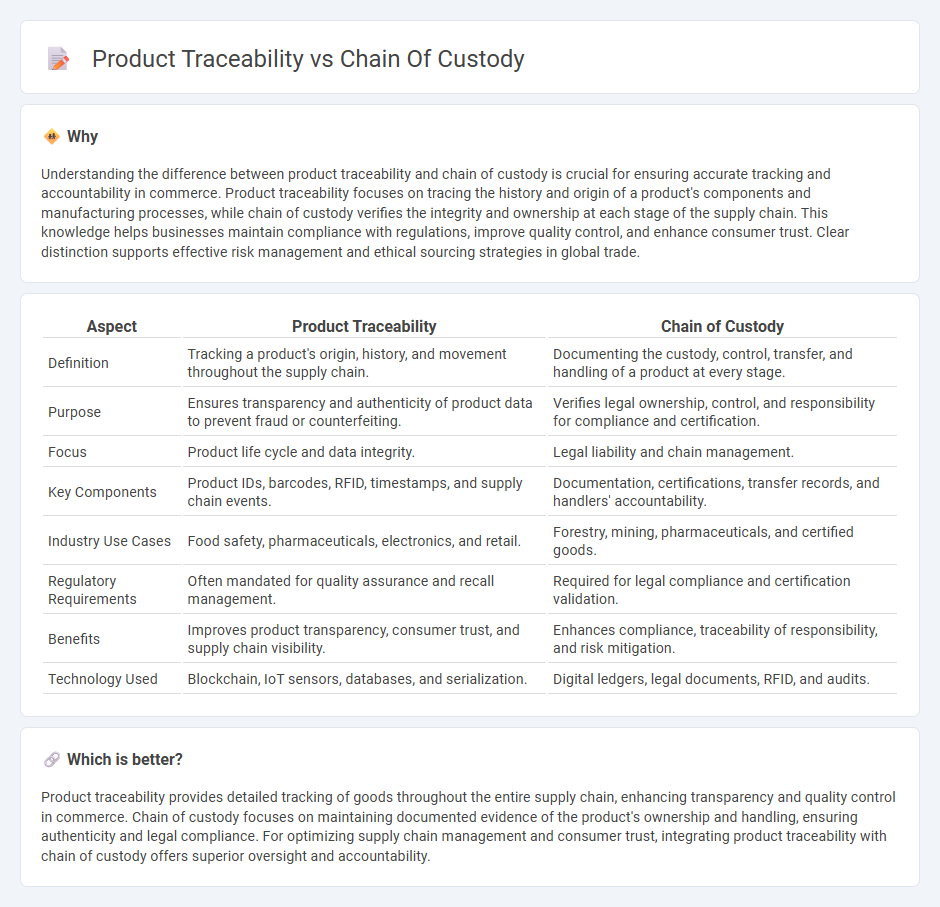
Product traceability ensures detailed tracking of goods through all stages of production, processing, and distribution, enhancing transparency and quality control. Chain of custody verifies the documented transfer of product ownership, maintaining the integrity of materials and compliance with legal or certification standards. Explore more about how these processes improve supply chain reliability and customer trust.
Why it is important
Understanding the difference between product traceability and chain of custody is crucial for ensuring accurate tracking and accountability in commerce. Product traceability focuses on tracing the history and origin of a product's components and manufacturing processes, while chain of custody verifies the integrity and ownership at each stage of the supply chain. This knowledge helps businesses maintain compliance with regulations, improve quality control, and enhance consumer trust. Clear distinction supports effective risk management and ethical sourcing strategies in global trade.
Comparison Table
| Aspect | Product Traceability | Chain of Custody |
|---|---|---|
| Definition | Tracking a product's origin, history, and movement throughout the supply chain. | Documenting the custody, control, transfer, and handling of a product at every stage. |
| Purpose | Ensures transparency and authenticity of product data to prevent fraud or counterfeiting. | Verifies legal ownership, control, and responsibility for compliance and certification. |
| Focus | Product life cycle and data integrity. | Legal liability and chain management. |
| Key Components | Product IDs, barcodes, RFID, timestamps, and supply chain events. | Documentation, certifications, transfer records, and handlers' accountability. |
| Industry Use Cases | Food safety, pharmaceuticals, electronics, and retail. | Forestry, mining, pharmaceuticals, and certified goods. |
| Regulatory Requirements | Often mandated for quality assurance and recall management. | Required for legal compliance and certification validation. |
| Benefits | Improves product transparency, consumer trust, and supply chain visibility. | Enhances compliance, traceability of responsibility, and risk mitigation. |
| Technology Used | Blockchain, IoT sensors, databases, and serialization. | Digital ledgers, legal documents, RFID, and audits. |
Which is better?
Product traceability provides detailed tracking of goods throughout the entire supply chain, enhancing transparency and quality control in commerce. Chain of custody focuses on maintaining documented evidence of the product's ownership and handling, ensuring authenticity and legal compliance. For optimizing supply chain management and consumer trust, integrating product traceability with chain of custody offers superior oversight and accountability.
Connection
Product traceability enables tracking the origin, processing, and distribution of goods, ensuring transparency and accountability throughout the supply chain. Chain of custody documents the continuous transfer of products from source to end consumer, maintaining integrity and preventing counterfeiting or tampering. Both concepts are essential for verifying authenticity, compliance with regulations, and enhancing consumer trust in commerce.
Key Terms
Documentation
Chain of custody documentation ensures an unbroken record of the product's ownership and handling, capturing every transfer point to maintain legal and regulatory compliance. Product traceability documentation details the product's history, use, and location by recording batch numbers, manufacturing dates, and supply chain movements to facilitate quality control and recalls. Explore more about how precise documentation enhances operational transparency and safety in supply chain management.
Tracking
Chain of custody ensures the documented and unbroken transfer of product custody, verifying authenticity and compliance from origin to endpoint. Product traceability encompasses broader tracking of product lifecycle data, including production, processing, and distribution stages for quality control and recall efficiency. Explore detailed methodologies to enhance both chain of custody and product traceability for optimized tracking systems.
Verification
Chain of custody emphasizes the verification of a product's journey through each stage of production, ensuring authenticity and preventing tampering by maintaining detailed records and secure documentation. Product traceability focuses on verifying the origins, processing history, and distribution path to enable precise identification of batches for quality control and recall management. Explore further to understand how these verification processes enhance supply chain integrity and consumer trust.
Source and External Links
What Is Chain of Custody? Definition and Examples - ThoughtCo - Chain of custody is a chronological paper trail that documents when, how, and by whom physical or electronic evidence was collected, handled, and controlled, ensuring legal acceptance and preventing tampering during investigations and trials.
Chain of custody - Wikipedia - Chain of custody is the documented sequence of custody, control, transfer, and analysis of evidence to maintain its integrity and authenticity, crucial for its admissibility in court and other contexts such as environmental sampling.
Law 101: Legal Guide for the Forensic Expert | Chain of Custody - The chain of custody is a recorded verification of the evidence's handling history, essential to prevent tampering or loss, maintain legal integrity, and ensure evidence is admissible and credible in court proceedings.
 dowidth.com
dowidth.com